US Air Forces in Europe is struggling with its identity.
Once the tip of America’s Cold War spear, standing ready with the very best aircraft to face down the Soviet Union, USAFE is now seeking the right posture in a theater where direct large-scale military threats are vague and allied partners seem to be disarming via budget cuts.
Intentionally or not, the Pentagon has drawn the identity issue in high relief, downgrading the position of USAFE’s commander from a four-star billet to a three-star job, when the next boss takes over on a timetable still to be worked out. Allies could easily construe the move as a sign that Washington considers European airpower less important than missions in other areas.
Asked how allies have reacted to the news that the Air Force’s European component will soon be led by a three-star, USAFE commander Gen. Mark A. Welsh III said the move hasn’t created any obvious distress. The other NATO countries are preoccupied with the “thrash and turmoil” of their own economic difficulties.
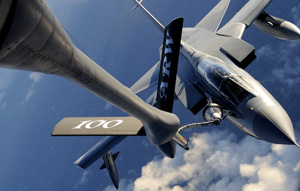 |
|
However, “the comment I get—kind of a joking comment—is, ‘Are you losing interest in Europe?’ ” For the allies’ part, he said, this is “a legitimate question.”
As NATO moves to a single air command, “it does create an interesting perspective from the NATO side,” Welsh noted. “Will a US three-star compete with other country four-stars” for the Alliance air commander job? “It just remains to be seen,” he said.
There are other hints that Washington’s focus has shifted elsewhere. The Air Force has never sent its top-of-the-line F-22s to Europe for a long visit, though it has sent them on extended deployments to Japan and Guam and based them in Hawaii. Likewise, USAF still has no firm plans to base F-35s in Europe, although bases in England, Germany, and Italy that are currently home to A-10 and F-16 squadrons are logical destinations.
To save money, the staffs of USAFE and Air Forces Africa—the air component to US Africa Command—will be reduced and combined. Third Air Force, USAFE’s operational component, will absorb AFRICOM’s17th Air Force, which will be inactivated. For USAFE, there’s “lots of pressure to create more efficiencies, figure out how to do the job for less money [and] fewer resources,” Welsh said in a June interview.
A few years ago, 17th Air Force was activated to meet the needs of AFRICOM, to manage interchanges with African air forces and supply airpower to AFRICOM’s commander. However, by the end of Fiscal 2012, 17th Air Force will fold its flag and 3rd Air Force will again provide planning and assets to serve both continents.
AFRICOM doesn’t want to lose “the momentum that they’ve gained” in doing partnership events with African countries, Welsh said. “We don’t want to lose it either, so as 17th Air Force is folded into our staff … we need to ensure that we continue to provide that same kind of support to Africa Command.”
With no additional assets to do that, though, choices must be made, Welsh said.
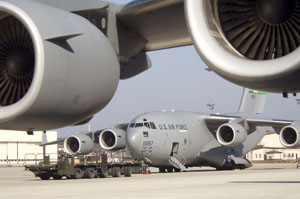 |
A C-17 is prepped for loading on the ramp at Ramstein AB, Germany. Ramstein is headquarters for USAFE. (USAF photo by MSgt. John E. Lasky) |
“We are going to have to very clearly prioritize activity both in Europe and in Africa,” he observed. He frankly admitted, “I don’t know if we can continue … the same level of effort.” That will be dictated by USAFE’s future force structure, he said. Both command staffs will have to “clearly understand where we can place priority of effort—who we can support, and who we can’t, and why.”
In cases where “both combatant commanders are very focused on a particular activity that involves the same resources in the same time span,” and negotiations can’t produce a workable answer, “I guess ultimately the Joint Staff will be the deciding body” on who gets priority. “But I don’t expect that to happen very often.”
Adm. James G. Stavridis, head of US European Command and NATO Supreme Allied Commander, Europe, has established three priorities for EUCOM—and thus USAFE—which Welsh summed up as: Win in Afghanistan, strengthen the NATO team, and shape the future of the Alliance.
Given those priorities—and the absence of a Soviet-style threat—what is USAFE’s principal mission
“Building partnership and partner capacity,” Welsh said. “It is the mainstream mission of the command—not just for USAFE, but all the components of EUCOM.”
To that end, Welsh said, USAFE conducts between 1,700 and 1,900 engagement events every year, both within the NATO Alliance and with other countries, under the Partnership for Peace program. These range from top-level military summits and major air exercises to delegations of one airman visiting a Belgian squadron for a week’s “immersion.”
“Strengthening the team” is a critical mission for USAFE.
Brainstorming
“The partners we have here in Europe are arguably the strongest partners the US has,” Welsh said. By helping them get stronger, it “gives us the ability to surge with capabilities we might not have resident in the US military.” More capability among the partners means less the US Air Force itself has to contribute.
Welsh noted that some NATO allies—particularly among the smaller, newer members—have little to no air capability. However, they make a strong effort to contribute within their means.
“Last year, we trained 72 NATO JTACs,” or joint terminal attack controllers, Welsh said. This year that number will double. “Right now, there are 214 NATO JTACs in Afghanistan,” he noted. “Every one of those guys is a JTAC the US doesn’t have to send.”
When he came to the job late last year, he expected to see some allies “doing everything, some nothing.” But he has been surprised by small countries “that don’t have a lot to give except their energy and their effort and their people. They’re all really committed.”
In an earlier interview, Welsh had included two more priority items with Stavridis’ top three: “Look for creative solutions and nontraditional partnerships.”
Creative solutions are a key to USAFE’s and NATO’s future. Partners are cutting their defense budgets significantly, and USAFE’s own resources will have to stretch to meet the needs of both EUCOM and AFRICOM.
 |
|
One idea that may well prove a model approach is called the Strategic Airlift Capability. Based at Papa AB, Hungary, the SAC is a cooperative effort by 12 countries: 10 NATO partners, including the US, and two non-NATO members, Sweden and Finland. The organization owns three C-17 airlifters, flown and maintained by all participants.
The organization is not a NATO unit and doesn’t come under NATO’s chain of command. However, a steering committee of partners chaired by a USAF general officer decides how the aircraft will be used, and how to apportion flying hours among the members. The SAC members all had a need to move people and large equipment long distances, to meet both NATO and independent requirements, but the purchase of C-17-like aircraft was beyond the means of most. By pooling their resources and creating a joint operating entity, called the Heavy Airlift Wing, all were able to meet their needs by chipping in on the airplanes and dividing flying time.
Welsh said the USAFE staff is “brainstorming ways” to use the SAC as a model for other needed capabilities.
One spinoff could be in remotely piloted aircraft, Welsh noted. USAFE is expecting to acquire MQ-9 Reapers when operations with that aircraft wind down in Afghanistan. Other NATO allies are pursuing their own RPA programs; Britain and Italy have already bought their own Reapers. Using the Air Force’s existing satellite communications and processing, exploitation and dissemination assets, RPAs could be a pooled mission.
One idea is to create an RPA center at Ramstein AB, Germany, where both USAF and partner air forces could develop “common architectures that allow you to share assets and sensor data,” Welsh observed. Partners with RPAs need more refinement of their RPA infrastructure, and “I think we can help [them] build that.”
Maj. Gen. Mark O. Schissler, then director of plans, programs, and analyses for USAFE, said in a June interview there’s “no reason” why an RPA consortium couldn’t work.
“ISR tends to be very expensive,” he noted, a principal reason NATO operates an AWACS program jointly. “No single nation wanted to shoulder the cost of that.” An ISR consortium would want the US to be a member, though, because “we have … the backbone of the ISR system. We already own that; it’s essentially in place.”
Just as in the US, however, the major obstacle to combining an RPA capability in Europe is how to integrate it with a congested commercial air traffic control system. In the US, FAA approval to operate Reapers is still in discussion; it will take even longer in Europe, Schissler said.
Another possible consortium approach to hardware would be in Baltic air policing, Welsh said.
Latvia, Lithuania, and Estonia have no air arms of their own, are in NATO’s far northeast, and clearly remember the decades they spent forcibly absorbed into the Soviet Union. The Baltic states have relied on NATO partners to perform air sovereignty patrols since 2004.
The three countries do have pilots, however.
“In my NATO hat, we’ve looked at … [whether] we can buy surplus fighters from somewhere, train a coalition, … a squadron, to live and operate in the Baltics and do the air policing full time,” Welsh said. That would be an improvement over USAF or other member air arms “rotating squadrons in for three or six months at a time.”
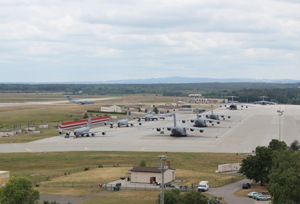 |
A C-17 taxis to the crowded ramp at Ramstein AB, Germany. The base is a critical waypoint for people and cargo moving to and from Afghanistan. (Staff photo by John A. Tirpak) |
Such a consortium would “want to pick an airplane that many countries are flying, so they could use crews from many countries.” He declined to nominate an airplane, but more NATO countries fly the F-16 than any other combat type.
Building a Bridge
There are “a lot of questions involved in this,” Welsh admitted—such as who would buy the airplanes, how the operations and maintenance costs would be shared, and “who’s going to manage the airfield.”
Schissler agreed that a fighter consortium poses some unique and thorny problems.
“It’s a little easier to think about a consortium doing airlift than it is about doing offensive combat missions,” he said. It is “hard to share” the authority for ordering an attack among 12 nations. There would have to be “extensive additional agreements about who’s got weapons release authority and things like that.” Such a deal would be arduous to negotiate, he said.
“That doesn’t mean it can’t be done, but it’s an additional challenge.” Tactical airlift could follow a model almost exactly like the SAC. Such an approach would be an extremely useful “bridge” for certain countries whose current tactical airlifters are almost out of useful life and that have seen delays in getting new A400s, built by EADS.
European partners in NATO have three main things they are anxious to learn from the US.
One is general tactics, techniques, and procedures, particularly with regard to “national sovereignty, airspace protection,” Schissler said.
Second is how USAF does aeromedical evacuation.
“Our system is recognized as being … successful” at getting injured people rapidly out of the combat zone and back to full-capability care, he said. Allies have seen it work not just for American personnel, but for their own injured who have been transported by USAF.
“Most of them don’t possess that and they invited us to show them our system, our people, our equipment.”
Finally, allies—particularly those in the East—are interested in how USAF manages logistics and aircraft maintenance. Schissler said the legacy Soviet-style “push” system sends parts as they are available, not necessarily when required. The American model is a “pull” system, in which parts are requested when needed.
“We find it to be more efficient, and it gives us a better mission reliability rate.” He explained that “if you’re waiting for the ‘push’ and it doesn’t come, …your jet’s always down.”
Welsh also anticipates a central role for USAFE in the European missile defense mission.
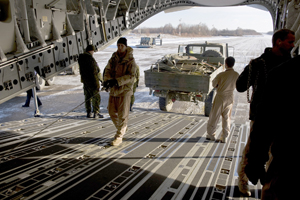 |
|
“One of the things the Air Force brings to [a] fight is the ability to command and control on a theater level,” Welsh said. The function of providing C2 to missile defense architecture isn’t much different from the “kind of command and control necessary to command big air operations across the breadth of a theater. Missile defense fits very neatly into that construct.”
While the Army and Navy have more extensive experience with “the tactical end of that business,” Welsh said USAFE’s air operations center will be the ideal place to manage missile defense, as it has pipes coming in from a variety of space-based and ground-based sensors that can provide data “from early warning to potential impact sites, to define and refine target areas, to allow some of the other pillars of missile defense to operate.”
Given that missile defense is a new mission, does USAFE need more people to do the job? Schissler said, “I’m really reluctant to say we’ll need more people because that’s something no one wants to hear.” He said USAFE hasn’t “sized” the mission yet, but “it will certainly be an additional task to what we do in Europe and USAFE.”
USAFE is doing more “expeditionary” work within the Alliance, and not just to Afghanistan. Command airmen regularly go on rotational trips to Bulgaria and Romania—”two-week trips, mostly,” Schissler noted. The Air National Guard also does it through the Partnership for Peace program.
Such excursions are usually to take advantage of what Schissler described as excellent training ranges in the eastern region of NATO.
“Those countries”—he included Poland in the group—”offer us really superb airspace to train in. They have way better ranges than we can get in some of the countries we currently operate in.”
Range access and limits on low-level flying in particular have been Alliance irritants for decades. Now, countries such as Britain and Germany don’t allow such training flights at all. To maintain proficiency, USAFE pilots must either go back to the US to participate in Red Flag exercises or go to the former Eastern Bloc.
“Sometimes, price comes into play,” Schissler said. Some countries “want an exorbitant price to operate there because we’re America.” Frequently, the cost avoidance of journeying back to the States for training makes the payment worthwhile. Under a recent agreement, the Air Force will, on a rotational basis, operate some of its F-16s and C-130s at two Polish bases. The aircraft will come from USAFE, the Guard, and the Reserve.
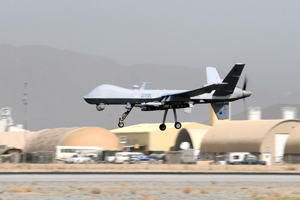 |
An RAF Reaper lands at Kandahar Airfield, Afghanistan. (RAF image by Cpl. Steve Follows) |
“Two-week rotations happen to fit very well with [the reserve components] if we give them good planning,” Schissler noted. The program is designed to improve interoperability between Poland and the US, and NATO broadly.
One of the biggest challenges facing USAFE is major reductions in defense budgets of allies.
Every nation has to make its own decisions about what it will cut, Schissler said, but “if everyone reduces fighters, are we going to have the fighter force structure that we want in NATO … collectively?” He said all the nations think their overhead is too large and “they’re going to reduce that by, notionally, about 20 percent.” Staffs are set to come down the same amount, he predicted. “But we have to take a minute and measure what we have left. And when it doesn’t meet our needs—not American needs, but NATO needs,” he said, “then we have to adjust.”
Schissler said his biggest concern about USAFE is that, in the zeal to reduce costs, the US might take what he called a “CONUS-centric” view and eventually cease to properly maintain the relationships, equipment, and forces in Europe.
“The kind of access and the kind of relationships we have with partners here require regular maintenance,” he said. The United States should not assume that in six months or a year the Air Force can fly back to a base in Europe and set up an expeditionary operation “if we’ve been absent from there, completely.”
|
Eyes and Ears Over Libya By June, the Air Force’s role supporting Operation Unified Protector, the NATO mission to defend civilians in Libya’s civil war, had switched away from direct attack to that of central support element. US Air Forces in Europe was providing “a lot of the key enablers,” said Gen. Mark A. Welsh III, USAFE commander. These include tankers, command and control, intelligence, surveillance, and reconnaissance assets, and other capabilities and capacities unique quantitatively to the United States. Is the Libya mission a strain on USAFE, which is already heavily supporting Afghanistan operations “I think everything is a strain,” Welsh replied. “Everybody is busy, … but it’s also what we do. … It’s why we have an Air Force; it’s why we’re trained.” However, when asked how long USAFE can continue at the pace it’s on, Welsh said, “It’s all a question of resources. It depends on the priorities of the nation. If it’s a high enough priority to the nation, we can sustain it.” |
|
The Base as a Weapon System Ramstein AB, Germany, is headquarters to US Air Forces in Europe, but the base should more accurately be regarded as a weapon system, asserted Brig. Gen. Mark C. Dillon, commander of the 86th Wing. The base in southwestern Germany is constantly transited by Air Mobility Command “heavies” transferring cargo and passengers to and from Afghanistan and other US Central Command locations. On a typical day in June, Ramstein’s ramp bulged with four C-5s and 12 C-17s, as well as its own 12 C-130J tactical transports, two large charter aircraft, three KC-135 tankers, and an array of resident VIP transports. The base also hosts air operations centers for both USAFE and US Air Forces Africa, the air component of US Africa Command. Nearby Landstuhl hospital is the way station for injured US troops airlifted from Afghanistan. Regular flights bring the injured to Ramstein for care at Landstuhl; those with more serious injuries are rapidly moved Stateside. Security forces at Ramstein give a refresher course to airmen being sent to Afghanistan in ground assignments “outside the wire.” The week-long course refamiliarizes the airmen with checkpoint procedures, convoys, small-arms tactics, spotting improvised explosive devices, and other combat skills. Ramstein offers a one-of-a-kind “decompression” program called “Combat Bridge,” designed to prepare airmen returning from Afghanistan to cope with the unexpected pressures and difficulties of returning to home life. In addition to base support functions, Ramstein is also a key storage area for munitions—important during the recent Libyan operations, Dillon noted. It hosts a construction organization that travels around USAFE and nearby areas, providing unique services such as maintenance and repair of runway arresting gear. The base also is home to a contingency response group that can set up expeditionary base communications and networks. |
|
Gates’ Warning to Europe NATO is flirting with irrelevancy if it doesn’t properly fund and size its military forces, Defense Secretary Robert M. Gates cautioned in June, before stepping down. Gates, in a parting shot to fellow NATO defense ministers at a meeting in Brussels, Belgium, noted the US military now accounts for more than 75 percent of NATO defense spending, up from a long-term average of 50 percent, he said. NATO’s European countries are cutting their defense budgets, and like the US, are seeing more of their defense dollars go to personnel costs rather than procurement. For example, Germany—USAFE’s host for several bases and thousands of US military personnel—plans defense cuts of 25 percent by 2015, the largest of any NATO member. Germany is also converting from a conscript force to volunteer military, meaning it will likely have to spend more to attract and retain qualified personnel. Elsewhere, Belgium and Italy are looking at 10 percent reductions by 2012 and 2014, respectively. Denmark and Britain are reducing defense by about seven percent over the next few years. France, having cut three percent already, is looking to go deeper. Spain cut 10 percent last year. One practical consequence of the ongoing defense spending cuts is that European NATO partners began running out of munitions just 11 weeks into the Libyan operation, Gates said, forcing the US to “make up the difference.” NATO has turned into a “two-tiered Alliance,” Gates asserted, made up of those who like to do “soft” tasks such as peacekeeping and humanitarian relief missions, and those willing to do “hard” tasks like combat. Those in the first group have the benefits of NATO membership “but don’t want to share the risks and the costs.” The American taxpayer has a “dwindling appetite and patience” to spend lavishly “on behalf of nations that are apparently unwilling to devote the necessary resources” to do their fair share and be “capable partners in their own defense,” Gates warned. Just five of 28 NATO countries meet the Alliance benchmark of spending two percent of GDP on their militaries, he said. |